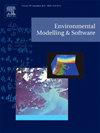GeoAI-based drainage crossing detection for elevation-derived hydrographic mapping
IF 4.8
2区 环境科学与生态学
Q1 COMPUTER SCIENCE, INTERDISCIPLINARY APPLICATIONS
引用次数: 0
Abstract
The increasing availability of High-Resolution Digital Elevation Models (HRDEMs) allows accurate delineation of stream and drainage flowlines at the field scale. However, the presence of digital flow barriers like roads effectively impedes hydrological connectivity represented on the HRDEMs. Conventional methods for locating these artificial barriers such as on-screen digitization and field surveying are cost prohibitive over large geographic areas. Thus, a database of drainage crossings under roads is a crucial input for refining flowlines derived from HRDEMs. In this study, we developed advanced deep learning models for detecting the locations of drainage crossing structures in agricultural areas. Our method assesses the performance of a two-stage object detector, Faster R-CNN and a single-stage object detector, YOLOv5. The models were trained using random HRDEM tiles and ground truth labels developed for the West Fork Big Blue Watershed, Nebraska. The Faster R-CNN and YOLOv5 achieved an average F1-score of 0.78. The best-fit models in Nebraska were then transferred to three other watersheds in Illinois, North Dakota, and California. These findings show effective spatial detection of these drainage crossing features, attributed to their distinct topographic patterns. Such spatial object detection approaches offer a promising avenue for automated integration of drainage crossings into HRDEMs with minimal manual interventions, thereby enhancing the delineation of elevation-derived hydrographic features for regional applications.
求助全文
约1分钟内获得全文
求助全文
来源期刊

Environmental Modelling & Software
工程技术-工程:环境
CiteScore
9.30
自引率
8.20%
发文量
241
审稿时长
60 days
期刊介绍:
Environmental Modelling & Software publishes contributions, in the form of research articles, reviews and short communications, on recent advances in environmental modelling and/or software. The aim is to improve our capacity to represent, understand, predict or manage the behaviour of environmental systems at all practical scales, and to communicate those improvements to a wide scientific and professional audience.
 求助内容:
求助内容: 应助结果提醒方式:
应助结果提醒方式:


